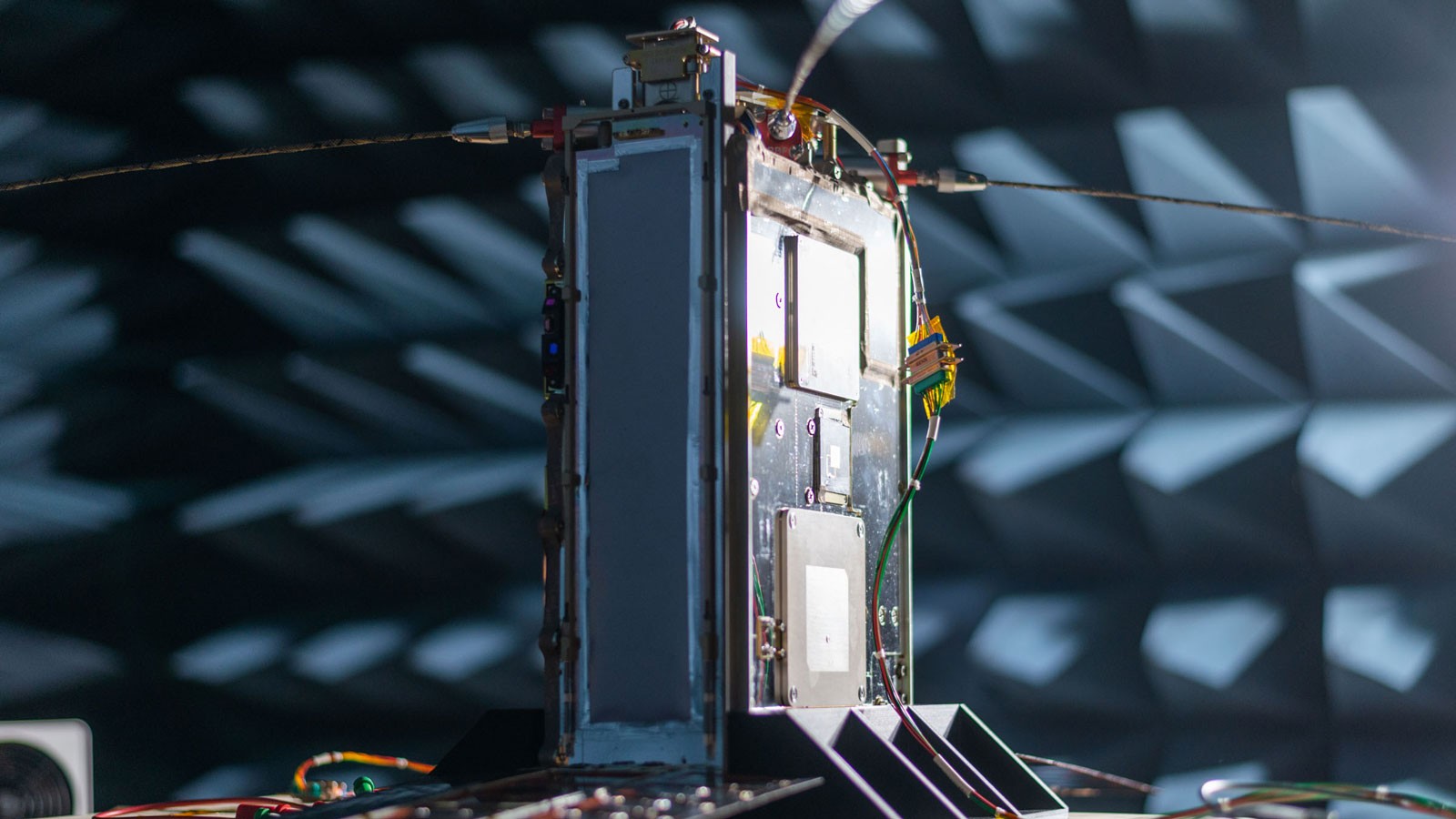Space Dynamics Lab Completes Critical Tests of Pathfinder Model for Constellation of Small Satellites
The SunRISE Protoflight Model satellite is pictured in an electromagnetic anechoic chamber at SDL on May 5, 2022, where it was tested to ensure the spacecraft does not interfere with the payload's sensitive measurements. The test was one of several critical functional and environmental tests completed on the satellite. (Allison Bills/SDL photo)
Utah State University’s Space Dynamics Laboratory announced Wednesday that it has completed a series of critical functional and environmental tests of the Protoflight Model satellite for NASA’s Sun Radio Interferometer Space Experiment mission, known as SunRISE. SunRISE will be a constellation of six small satellites built and tested at SDL.
SunRISE is led by Principal Investigator Justin Kasper at the University of Michigan in Ann Arbor and is managed by the Jet Propulsion Laboratory in Pasadena, California. It is scheduled to launch as a hosted rideshare with a commercial satellite no earlier than July 2023.
Once launched, the constellation of six CubeSats will fly in a loose formation, acting as a single radio telescope to observe low-frequency emissions from solar activity and share the data with scientists via NASA’s Deep Space Network.
The SunRISE Protoflight Model satellite underwent rigorous functional and environmental testing to validate the satellite’s design before production begins on the remaining five satellites in the constellation. SDL performed the tests at the lab’s facilities on USU’s Innovation Campus, where engineers put the satellite through its paces under simulated conditions in specially designed chambers.
This testing replicated what the constellation will experience on the way to space and evaluated how it will perform in the harsh conditions of geosynchronous orbit at an altitude of about 35,800 kilometers, its final destination.
The integrated Protoflight Model satellite combines a spacecraft designed and built by SDL with a science payload designed and built by JPL. In addition to validating the design, this prototype satellite, which weighs just 12 kilograms, will enable mission engineers to practice and refine the various tests required to demonstrate flight readiness.
SunRISE is designed to observe powerful solar storms that send trillions of tons of charged matter toward Earth. These storms have broad implications for life on Earth and beyond. Solar storms feed into Earth’s complex space weather system, which, just like terrestrial weather, affects many of our daily Earthbound activities. For example, space weather can knock out power grids or block radio communications.
Solar storms can also affect space systems, damaging Earth-orbiting satellites or endangering future astronauts who will travel to the moon or Mars. SunRISE data will provide insights into solar physics and space weather that will help scientists predict and prepare for solar storms.
“One of the unique attributes of SunRISE as a small satellite constellation is that the payloads are very sensitive to electromagnetic interference. As such, the Protoflight Model was tested in an electromagnetic anechoic — or echo-canceling — chamber to ensure the spacecraft does not interfere with the payload’s sensitive measurements,” said Tim Neilsen, SDL’s program manager for SunRISE. “Satellite functional and environmental testing is a vital step to ensure the satellites will perform as designed while on orbit. SDL’s small satellite test and evaluation capabilities reduce flight hardware risk and give our mission partners confidence that these important missions can be completed successfully.”
Satellite launch vehicles undergo intense turbulence leaving Earth to reach their destinations. Vibration during liftoff can rattle a satellite’s electrical connections and shake loose parts if not designed and assembled to exacting standards. To evaluate workmanship quality, SDL subjected the Protoflight Model to a vibration test that simulates the rocket launch, ensuring the satellite is structurally sound.
“The satellite also passed through a thermal vacuum test, which simulates both the vacuum and extreme temperature fluctuations it will experience in space,” Neilsen said. “The successful functional and environmental testing on the Protoflight Model demonstrates that the design meets mission requirements and provides NASA the assurance that SDL is ready to fabricate and test the remaining five satellites.”
Since 1959, SDL has been solving the technical challenges faced by the military, science community, and industry and supports NASA’s mission to drive advances in science, technology, aeronautics, and space exploration to enhance knowledge, education, innovation, economic vitality, and stewardship of Earth. SDL is a research laboratory headquartered in North Logan, Utah, and has offices in Albuquerque, New Mexico; Colorado Springs, Colorado; Dayton, Ohio; Houston, Texas; Huntsville, Alabama; Los Angeles, California; Stafford, Virginia; and Washington, D.C. For more information, visit www.sdl.usu.edu.
CONTACT
Eric Warren
Director, Public Relations
Space Dynamics Laboratory
435-881-8439
eric.warren@sdl.usu.edu
TOPICS
Space 139stories SDL 89stories NASA 82stories Satellites 67storiesComments and questions regarding this article may be directed to the contact person listed on this page.







